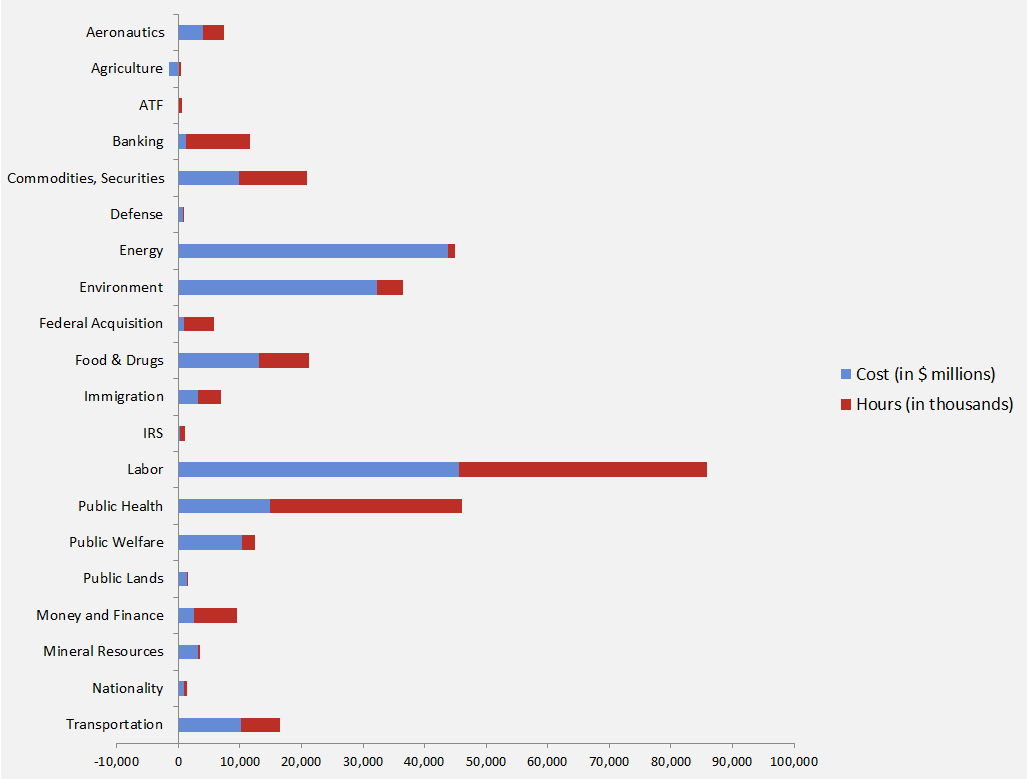Week in Regulation
November 21, 2016
Midnight Regulations Rise
This is either the beginning of a midnight uptick in regulation or an otherwise busy week for federal regulators. There were 19 new regulations this week that quantified costs or paperwork hours. Combined, they imposed $2.4 billion in total costs, $1 billion in annual burdens, and $623 million in benefits; paperwork accelerated by 8.2 million hours. These figures exclude two proposed rules from 2016 that went final this week, combining for another $2.3 billion in burdens. There were five final rules with annualized costs above $100 million. The per capita regulatory burden for 2016 is $618.
Regulatory Toplines
- New Proposed Rules: 32
- New Final Rules: 59
- 2016 Total Pages of Regulation: 83,105
- 2016 Final Rules: $153 Billion
- 2016 Proposed Rules: $47.2 Billion
The American Action Forum (AAF) has catalogued regulations according to their codification in the Code of Federal Regulations (CFR). The CFR is organized into 50 titles, with each title corresponding to an industry or part of government. This snapshot will help to determine which sectors of the economy receive the highest number of regulatory actions.
The Securities and Exchange Commission (SEC) was responsible for three major regulations this week. The largest, “Liquidity Risk Management Programs,” imposes annual burdens of $152 million, with nearly 300,000 paperwork burden hours. The rule would attempt to enhance disclosure about liquidity and redemption practices.
SEC also finalized a pair of rules for investment company “Swing Pricing” and “Reporting Modernization.” The former amends Form N-1A and Regulation S-X to address swing pricing. The latter aims to modernize reporting and disclosure by registered investment companies. Combined, they would impose more than $450 million in annual costs and 2.1 million paperwork burden hours.
The Department of Labor finalized its “Fall Protection Systems” rule, a measure first introduced in 1998, and which was proposed in 2010. The 513-page (!) regulation revises standards for ladders, rope descents, and personal fall protection systems. The agency estimates it will prevent 5,842 injuries annually and 29 deaths. This will generate more than $600 million in benefits, compared to $305 million in annual costs.
Tracking Midnight Regulation
This week, OIRA received nine regulations, up from four last week; all but two were final rules and five were economically significant. OIRA discharged 16 regulations, up from five from last week, including eight economically significant measures, up from just one last week. During a 48-hour period, OIRA approved ten rules, including six economically significant measures. Notable regulations released last week include:
According to a calculation from the Congressional Research Service, all regulations submitted to Congress or published (whichever is later) after May 30, 2016 will be subject to the Congressional Review Act’s disapproval process next year.
Affordable Care Act
Since passage, based on total lifetime costs of the regulations, the Affordable Care Act has imposed costs of $51.6 billion in final state and private-sector burdens and 172.4 million annual paperwork hours.
Dodd-Frank
Click here to view the total estimated revised costs from Dodd-Frank; since passage, the legislation has produced more than 74.8 million final paperwork burden hours and imposed $36.5 billion in direct compliance costs.
Total Burdens
Since January 1, the federal government has published more than $200 billion in compliance costs ($153 billion in final rules) and has imposed 138 million in net paperwork burden hours (109 million from final rules). Click below for the latest Reg Rodeo findings.











